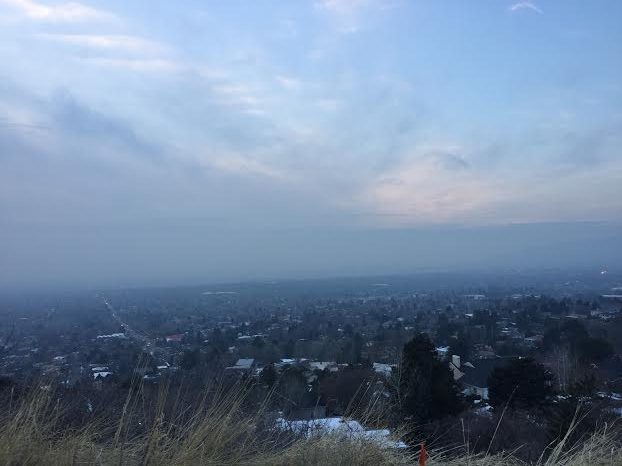High Quality Students, Low Quality Air
The inversion as seen from above.
January 19, 2018
Over the last few months our city has been covered in gray and seeing a clear blue sky has been a rare occasion. The air quality in Salt Lake City continues to be poor, and the AP environmental science students, with the help of Monica French are studying just what exactly we breathe in.
As the cold air gets trapped under the warm air in the winter time, the air quality decreases. The particles in the air affect the health of everyone who breathes it in. The particles that sneak into our lungs are called PM2.5’s. The particulate matter impairs the respiratory capacity and the air is particularly dangerous for those with asthma or other health problems like heart disease.
“We live in a valley, and we are surrounded by mountains. We are constantly putting pollutants out and normally what happens is that the wind or air currents come through and they take away our pollution,” French said.
However, when the wind or air currents cannot take away the pollution we make, it builds and builds and grows and grows, and eventually we are “living in the soup of the stuff we made,” as French describes it.
The AP environmental science students see this as a hazard and most of them feel passionate about the subject. They have been working on collecting data over the last 10 days on the quality of the air.
Camille Whisenant, Ap environmental science student has received a new understanding of air quality and its importance. Whisenant realizes and believes that we need to take into consideration the harmful effects of the pollution and emissions in the air.
“We have been learning about bioengineering and APES has taught me some of the ways that people want to fix [poor air quality], but almost every solution there is, has detrimental trade offs,” Whisenant explained.
Whisenant and her peers are being educated on the topic at a vital time, and if students in our generation are well learned we can work to improve the very air that gives us life.
French strongly believes that we should fix the things we break and that through education, we can impart change. She implements this mindset in her students as she teaches that as long as we know things, we can change things.
“We should never be at the mercy of everyone else. We should definitely be aware of what we create and how we live with what we create,” French said. “To live day in and day out with this poor quality of air, has an impact on everyone’s health. The sooner and better you are to get educated about that, the more likely you are to ask those who can possibly make change to be apart of the change.”
French shows her students the problem, and explains how to fix it. Automobile pollution is one of the main causes of our inversion, and French encourages people to be willing to help that problem by walking or carpooling every once in a while.
“The most important thing is to know that it isn’t an accident that we have this poor quality air. This poor quality air is very anthropogenic in origin. We created this environment,” French said. “There are definitely some steps that could be made here in Salt Lake City to change it, but it requires an enormous amount of behavior changes and effort.”
Because French sees that there is a possibility of improvement, the need to educate people on the topic grows even more important. Being aware of what is going on around us gives us the power and control we need to implement changes and look for improvements.




























